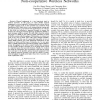INFOCOM
2008
IEEE
14 years 6 months ago
2008
IEEE
—Intelligent transportation systems have become increasingly important for the public transportation in Shanghai. In response, ShanghaiGrid (SG) aims to provide abundant intellig...
INFOCOM
2008
IEEE
14 years 6 months ago
2008
IEEE
—We develop opportunistic scheduling policies for cognitive radio networks that maximize the throughput utility of the secondary (unlicensed) users subject to maximum collision c...
INFOCOM
2008
IEEE
14 years 6 months ago
2008
IEEE
—Wireless Multimedia Sensor Networks (WMSNs) are networks of wirelessly interconnected devices that allow retrieving video and audio streams, still images, and scalar sensor data...
INFOCOM
2008
IEEE
14 years 6 months ago
2008
IEEE
In this report, we will provide the detailed theoretical analysis including some omitted proofs in our latest submission to Infocom 2008. For more details about the framework prot...
INFOCOM
2008
IEEE
14 years 6 months ago
2008
IEEE
—We introduce Zen, a new resource allocation framework that assigns application components to node clusters to achieve high availability for partial-fault tolerant (PFT) applicat...
INFOCOM
2008
IEEE
14 years 6 months ago
2008
IEEE
INFOCOM
2008
IEEE
14 years 6 months ago
2008
IEEE
—Channel assignment is a very important topic in wireless networks. In this paper, we study FDMA channel assignment in a non-cooperative wireless network, where devices are sel�...
INFOCOM
2008
IEEE
14 years 6 months ago
2008
IEEE
—Abstract—In recent years, numerous large-scale Wireless LANs (WLAN) have been deployed all over the world. However, the shortage of non-interfering channels makes it a challen...
INFOCOM
2008
IEEE
14 years 6 months ago
2008
IEEE
—The physical layer of future wireless networks will be based on novel radio technologies such as UWB and MIMO. One of the important capabilities of such technologies is the abil...
INFOCOM
2008
IEEE
14 years 6 months ago
2008
IEEE
Abstract—Latency reduction in distributed interactive applications has been studied intensively. Such applications may have stringent latency requirements and dynamic user groups...




